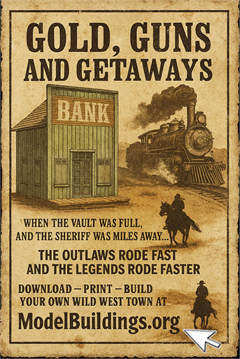Everything on model trains, model railroads, model railways, locomotives, model train layouts, scenery, wiring, DCC and more. Enjoy the world's best hobby... model railroading!
Causes of Poor Solder Joints
Jason sent in these thoughts:
Poor solder joints can be a big time waster and cause endless electrical problems on a model railroad layout. Keeping the solder iron tip in first class condition is critical if you want to achieve sound solder joints. Tip problems are easily prevented by always keeping the tip tinned with a thin coating of solder.
Most tips on solder irons are manufactured using a copper core which has been electroplated with iron to prolong the life of the iron. The “non-working” part of the tip is usually plated with nickel to protect against rusting and corrosion. It is then plated with chrome to stop the solder from sticking to it. It is only the very end tip that is un-plated so it will hold the solder.
Recommended model train resources
Looking after a solder iron is important – especially the unplated part of the tip that will quickly oxidize. This is why you need to coat the tip with solder at all times. It will slow down the oxidation process and help keep the tip in good condition. Despite your best intentions, the tip will eventually burn out – they all do. You know this has happened if you struggle to maintain the tip in a clean and shiny condition. If this happens the tip will need to be replaced. Filing or sanding the tip will not solve the problem long term. Tip replacement is best.
To avoid pre-mature burn out of the tip, keep it tinned with a thin coating of solder – not just while you are doing some soldering, but also when your soldering iron is idling. Get into the habit of applying a coat of solder to the tip before you set the iron down.
After you have finished soldering, always clean the tip and then apply a coating of solder prior to switching the iron off.
Whenever you buy and install a new tip, begin by applying a thin coating of solder, because otherwise the tip could burn out within a few minutes.
4 Responses to Causes of Poor Solder Joints
Leave a Reply















In reference to your comments on Soldering. I have spent many hours in my career, soldering electrical terminations in electrical control panels. The tip is actually plated with Tin, not Nickel and should be periodically wiped using a small sponge (as supplied with a “Weller” soldering system. Your tip will last for monthes, if this tecnique is used. The Weller unit also thermostatically controls the tip temperature to insure against overheating and subsequent burning of the Tips.
Regards,Terry Southgate
I have used both tin and nickel solder, the newer nickel type solder doesn’t work that well. and needs a higher temperature to melt. although wiping it regularly does help, the higher temp of the solder burns tips out. unfortunately that life. live with it.
There are a number of causes for “bad” solder joints, the commonest being surface contamination and insufficient heat in the right place. .
Surfaces which are not clean, but covered with a layer of oxide or dirt or paint will not solder.
The next most common cause of bad solder joints is a failure to “tin” the iron with solder before applying it to the part to be soldered. The liquid layer of solder on the tip allows much better transfer of heat to the parts to be soldered.
A “dry” iron will not transfer heat so nicely to the joint and will give rise to “cold-soldered joints” and you will find you spend too much time trying to heat the places to be joined and have heat spread to places where you don’t want heat.
First “tin” the soldering iron tip, wipe off any “blob” of solder using a small wad of paper towel, or cotton rag (NOT a synthetic blend, it will melt!) or a damp sponge like the Weller irons.
Next tin the bare end of wire. Apply the wire to the tip of the iron and apply a touch of flux-cored solder to that place. The solder should run onto the end of the wire, and just coat the wire. Wipe off any “blob” that is left with a piece of paper towel or clean cotton rag. Do not burn your fingers!
Next make sure the soldering iron tip is still solder coated, then apply the iron’s tip to the heaviest part to be soldered-i.e. the rail- then apply a touch of flux-cored solder to that point while the iron is there to allow a small run of solder to flow onto the surface. (You will then have “tinned” the second surface to be joined.) Lift off the iron, apply the wire, and then put back the iron on top to liquefy the solder to cause it to “run” to make the joint.
Lift off the iron & blow on the joint while you hold the wire in place, to cool the solder back to solid more quickly.
I bought an Ungar Soldering Station back in 1972 and it saw daily use for about 20 years. I started using it again, on an almost daily basis, about 2 years ago. It came with two tips, a fine and a broad point. I replaced the fine point with a new one about a year ago, the original had worn down to almost a stub. I had trouble finding parts but eventually did find some on eBay USA.
By following good practices like Bernard suggested, I have not had a problem with the station or with the solder joints. Unfortunately original tip cleaning pads are not available, so I am going to procure some Weller ones even if the size is not quite correct, they will still work.